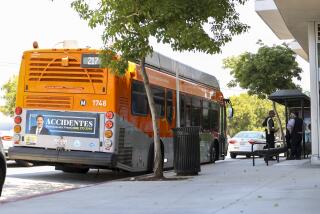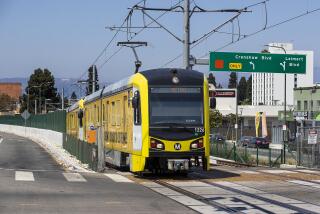3-City Group Begins Traffic Study : Commuting: A frustrated coalition is driven to seek its own answers for congestion in downtown Glendale, Pasadena and Burbank.
- Share via
A coalition of Pasadena, Glendale and Burbank representatives, feeling ignored by a Los Angeles-oriented traffic bureaucracy, has launched a $150,000 study to explore suburb-to-suburb commuting among the three cities.
“We’re trying to get rid of congestion in downtown Glendale, downtown Burbank and downtown Pasadena,” said Glendale City Councilman Carl W. Raggio, chairman of the Tri-City Transportation Coalition, which is overseeing the study.
“The freeways are inadequate and filled to capacity,” Raggio said. “You’ve got to have alternative ways of moving people.”
Coalition board member David Barnhart, Pasadena’s city engineer and transportation manager, added: “The jobs-housing balance is not an academic concept anymore. The suburb-to-suburb commute is just exploding.”
As evidence of this, he said, traffic on the Foothill Freeway through the San Gabriel Valley has increased by 27% during the last three years.
The Tri-City Transportation Coalition was formed last year by business, government and community leaders who thought that regional and state transportation agencies had ignored their collective needs.
Banding together last September after a series of transportation seminars sponsored by chambers of commerce from the three cities, the coalition took its complaints to the transportation agencies’ planners.
In response, the Southern California Assn. of Governments is contributing $100,000 and the Southern California Rapid Transit District is paying for the rest of the one-year study. It will analyze everything from Dial-A-Ride programs to commuter buses, light rail, commuter trains, car-pool lanes and trolleys.
The state Department of Transportation, the Los Angeles County Transportation Commission and the staffs of the three cities will also be involved.
The multiagency study team will come up with a report meant to be used as a lobbying tool to gain funding for transportation projects benefiting the three cities.
“Tri-City wants this to be the most comprehensive look ever at east-west transportation in the corridor,” coalition spokesman Nat Read said.
As an example of the problem, coalition members cite the planning for commuter rail and light-rail trains in Los Angeles County and say it has failed to adequately consider transportation connections in the three cities.
For example, a proposed Pasadena-to-Los Angeles light rail would do little to help commuters in Burbank and Glendale, they say.
And a proposed commuter train from Moorpark to downtown Los Angeles is to make stops in Burbank and Glendale. But, Raggio asked, how would someone use that train route and get to work in Pasadena?
Much of the transportation planning in the 1960s and 1970s, Raggio said, considered downtown Los Angeles as the hub of the county and ignored how the spokes might connect.
“Once,” Raggio said, “you worked in L.A. and you lived in the suburbs. But the suburbs have become more and more commercial and retail. And they’ve become work centers.” High-rise office buildings, he said, have sprouted above the landscapes of the three cities and draw commuters daily from throughout Southern California.
The cities might have received more attention earlier from the traffic bureaucracies had they banded together sooner, said project manager Bijan Yarjani of the transportation department of the Southern California Assn. of Governments.
However, he said: “I’m not sure they have been neglected. But the level of congestion has not been as great there as probably some other places in L.A. County.”
Yarjani is scheduled to brief the coalition on the progress of the study today in Pasadena during the group’s monthly meeting.
One idea being considered is a proposal to solve the cities’ traffic woes with a tri-city trolley system linked by buses. Raggio and a number of other coalition members favor the proposal.
The study also will determine “where people are coming from, where are they going, and how many are just passing through,” Yarjani said.
“With the amount of funding involved, we can’t look at everything in depth,” Yarjani said. But he said the problem can be quantified and decisions made on “what is the quickest, short-term way to solve the problem without spending a lot of money.”
More to Read
Sign up for Essential California
The most important California stories and recommendations in your inbox every morning.
You may occasionally receive promotional content from the Los Angeles Times.










